Cue notation is a way to transcribe handshape and placement sequences using numbers and letters (e.g., 3t1m indicates how one would cue the word happy). This system is not a written language for Cued Speech users. Native cuers use the written form of the language they cue (e.g., written English for cued English users). Cue notation simply indicates how a word is cued, which can be helpful for students while learning to cue.
Format
Handshapes
Each handshape is assigned a number from one to eight. This number is solely for reference and does not indicate the how the English words for numbers (e.g., six, eight, one) are cued. The numbers generally correspond to the number of extended fingers when the handshape is formed. For example, the handshape for /ddddddddd/ is produced with only the pointer finger extended. It is referred to as Handshape 1. The handshape for /kkkkkkkkk/ is produced with the index and middle fingers extended. That handshape is referred to as Handshape 2. The handshape for /hhhhhhhhh/ requires the cuer to extend the middle, ring, and pinky fingers. That handshape is referred to as Handshape 3. The handshape that represents /bbbbbbbbb/ uses all four extended fingers with the thumb hidden. This is handshape 4.
After Handshape 5 (for which all five fingers are extended), the thumb carries a value of five. So the handshape for /lllllllll/ (with the thumb and index finger extended) is referred to as Handshape 6. The exception to these guidelines is Handshape 8. Handhshape 8 is formed similarly to Handshape 2 by extending the index and middle finger, however, the fingers are spread apart. The table below shows an illustration for each hanshape with its cue notation symbol.
| Handshape | Symbol | Phonemes |
|---|---|---|
 |
1 | /ddddddddd, ppppppppp, ʒzhzhʒzhzhʒzhzh/ |
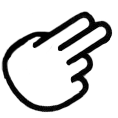 |
2 | /kkkkkkkkk, vvvvvvvvv, ðt͟htHðt͟htHðt͟htH, zzzzzzzzz/ |
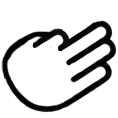 |
3 | /hhhhhhhhh, rrrrrrrrr, sssssssss/ |
 |
4 | /bbbbbbbbb, nnnnnnnnn, ʍhwhwʍhwhwʍhwhw/ |
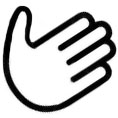 |
5 | /mmmmmmmmm, fffffffff, ttttttttt/ |
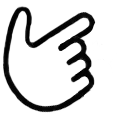 |
6 | /lllllllll, ʃshshʃshshʃshsh, wwwwwwwww/ |
 |
7 | /ʤjjʤjjʤjj, ggggggggg, θththθththθthth/ |
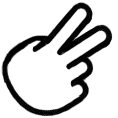 |
8 | /ʧchchʧchchʧchch, jyyjyyjyy, ŋngngŋngngŋngng/ |
Fonogesty
An exception to the numbering system is Cued Speech adaptation for Polish – Fonogesty. Our handshape 5 is referred to as Układ 1 in Fonogesty. Our handshape 3 is their Układ 8.
Placements
The placements are each assigned a letter corresponding to the first letter of the name for the placement. The letter "c" stands for the "chin" and "m" stands for the "mouth".
| Placement | Symbol | Phonemes |
|---|---|---|
| chin | c | /ɔôawɔôawɔôaw, ɛěehɛěehɛěeh, uo͞oueuo͞oueuo͞oue/ |
| mouth | m | /iēeeiēeeiēee, ɚûrurɚûrurɚûrur/ |
| throat | t | /æăaæăaæăa, ɪĭiɪĭiɪĭi, ʊo͝oooʊo͝oooʊo͝ooo/ |
| side | s | n/a (consonant alone) |
| side-down | sd | /ʌŭuhʌŭuhʌŭuh, əəəəəəəəə/ |
| side-forward | sf | /ɑäahɑäahɑäah, oʊōohoʊōohoʊōoh/ |
Sample Cue Notation
Because cueing represents consonant-vowel units, both the number (handshape) and letter (placement) must be written sequentially. Following are some examples:
| Word | Phonemes | Meta Information | Cue Notation |
|---|---|---|---|
| He | /hhhhhhhhhiēeeiēeeiēee/ | = handshape 3 = mouth placement |
3m |
| she | /ʃshshʃshshʃshshiēeeiēeeiēee/ | = handshape 6 = mouth placement |
6m |
| Him | /hhhhhhhhhɪĭiɪĭiɪĭimmmmmmmmm_/ | /hhhhhhhhh/ = handshape 3 /ɪĭiɪĭiɪĭi/ = throat placement /mmmmmmmmm/ = handshape 5 _ = side placement (consonant alone) |
3t5s |
| Her | /hhhhhhhhhɚûrurɚûrurɚûrur/ | /hhhhhhhhh/ = handshape 3 /ɚûrurɚûrurɚûrur/ = mouth placement |
3m |
| Eat | /iēeeiēeeiēee_ttttttttt_/ | _ = handshape 5 (no consonant) /iēeeiēeeiēee/ = mouth placement /ttttttttt/ = handshape 5 _ = side placement (consonant alone) |
5m5s |
| You | /jyyjyyjyyuo͞oueuo͞oueuo͞oue/ | /jyyjyyjyy/ = handshape 8 /uo͞oueuo͞oueuo͞oue/ = chin placement |
8c |
| Heater | /hhhhhhhhhiēeeiēeeiēeetttttttttɚûrurɚûrurɚûrur/ | /hhhhhhhhh/ = handshape 3 /iēeeiēeeiēee/ = mouth placement /ttttttttt/ = handshape 5 /ɚûrurɚûrurɚûrur/ = mouth placement |
3m5m |
| Finish | /fffffffffɪĭiɪĭiɪĭinnnnnnnnnɪĭiɪĭiɪĭiʃshshʃshshʃshsh_/ | /fffffffff/ = handshape 5 /ɪĭiɪĭiɪĭi/ = throat placement /nnnnnnnnn/ = handshape 4 /ɪĭiɪĭiɪĭi/ = throat placement /ʃshshʃshshʃshsh/ = handshape 6 _ = side placement (consonant alone) |
5t4t6s |
| Streets | /sssssssss_ttttttttt_rrrrrrrrriēeeiēeeiēeettttttttt_sssssssss_/ | /sssssssss/ = handshape 3 _ = side placement (consonant alone) /ttttttttt/ = handshape 5 _ = side placement (consonant alone) /rrrrrrrrr/ = handshape 3 /iēeeiēeeiēee/ = mouth placement /ttttttttt/ = handshape 5 _ = side placement (consonant alone) /sssssssss/ = handshape 3 _ = side placement (consonant alone) |
3s5s3m5s3s |
Diphthongs
Diphthongs are two vowels that occur together in a single syllable. When cued, the hand moves from one vowel placement to another with handshape 5 occuring for the second vowel. In cue notation, diphthongs may be shown without spaces or with hyphens:
hey = 3c5t or 3c-5t
how = 3s5t or 3s-5t
Other Conventions
Flicks
Flicks can be represented with an apostrophe (') or an asterisk (*). This site uses an asterisk to avoid confusion with stress marks shown in the pronunication (e.g., raft).
Commas
Sometimes a comma (,) is used between cued segments (e.g., happiness 3t, 1m, 4t, 3s).
Benefits of Cue Notation
Notetaking
For beginners, cue notation is a valuable tool in that it allows them to record how words are cued. By transcribing the handshape-placement combinations, they can refer back to words on their own and see how they were cued during class. While not every word may be transcribed during an introductory course, cue notation can be used for several words in each lesson and for for tough-to-cue words.
Instruction
Another advantage for new cuers is the process of writing cue notation. In order to transcribe words, they must group segments into consonant-vowel pairs. This allows them to systematically break words down in the way they will need to be cued while also allowing them to self-monitor (on paper) whether they did so accurately. This can be an important intemediary step for new cuers. While they won't transcribe every word before cueing it, students can learn to use cue notation as a step for words that they struggle to cue.
Additionally, cue notation provides a "road map" to cueing. For students who are unsure whether they should return tothe side placement for a word, cue notation supplies the answers (e.g., no is cued as 4sf and known as 4sf 4s).
Correspondence/ Text
One of the greatest advantages of cue notation is that it can be typed. Beginner cuers can e-mail instructors for advice on how to cue a word and the response can be sent as letters and numbers rather than as a large video file.